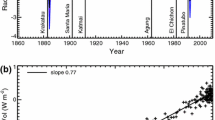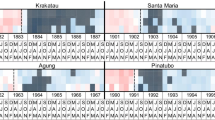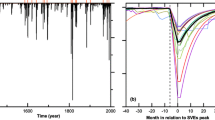Abstract
The radiative flux perturbations and subsequent temperature responses in relation to the eruption of Mount Pinatubo in 1991 are studied in the ten general circulation models incorporated in the Coupled Model Intercomparison Project, phase 3 (CMIP3), that include a parameterization of volcanic aerosol. Models and observations show decreases in global mean temperature of up to 0.5 K, in response to radiative perturbations of up to 10 W m−2, averaged over the tropics. The time scale representing the delay between radiative perturbation and temperature response is determined by the slow ocean response, and is estimated to be centered around 4 months in the models. Although the magniude of the temperature response to a volcanic eruption has previously been used as an indicator of equilibrium climate sensitivity in models, we find these two quantities to be only weakly correlated. This may partly be due to the fact that the size of the volcano-induced radiative perturbation varies among the models. It is found that the magnitude of the modelled radiative perturbation increases with decreasing climate sensitivity, with the exception of one outlying model. Therefore, we scale the temperature perturbation by the radiative perturbation in each model, and use the ratio between the integrated temperature perturbation and the integrated radiative perturbation as a measure of sensitivity to volcanic forcing. This ratio is found to be well correlated with the model climate sensitivity, more sensitive models having a larger ratio. Further, if this correspondence between “volcanic sensitivity” and sensitivity to CO2 forcing is a feature not only among the models, but also of the real climate system, the alleged linear relation can be used to estimate the real climate sensitivity. The observational value of the ratio signifying volcanic sensitivity is hereby estimated to correspond to an equilibrium climate sensitivity, i.e. equilibrium temperature increase due to a doubling of the CO2 concentration, between 1.7 and 4.1 K. Several sources of uncertainty reside in the method applied, and it is pointed out that additional model output, related to ocean heat storage and radiative forcing, could refine the analysis, as could reduced uncertainty in the observational record, of temperature as well as forcing.






Similar content being viewed by others
References
Ammann CM, Meehl GA, Washington WM, Zender CS (2003) A monthly and latitudinally varying volcanic forcing dataset in simulations of 20th century climate. Geophys Res Lett 30(12):1657. doi:10.1029/2003GL016875
Angell JK (2000) Tropospheric temperature variations adjusted for El Niño, 1958–1998. J Geophys Res 105(D9):11841–11849
Barkstrom BR (1984) The earth radiation budget experiment (ERBE). Bull Am Meteor Soc 65:1170–1185
Barkstrom BR, Smith GL (1986), The earth radiation budget experiment: Science and implementation. Rev Geophys 24:379–390
Boer GJ, Stowasser M, Hamilton K (2007) Inferring climate sensitivity from volcanic events. Clim Dyn 28(5):481–502
Bradley RS (1988) The explosive volcanic-eruption signal in northern hemisphere continental temperature records. Clim Change 12(3):221–243
Church JA, White NJ, Arblaster JM (2005) Significant decadal-scale impact of volcanic eruptions on sea level and ocean heat content. Nature 438:74–77
Douglass DH, Knox RS (2005) Climate forcing by the volcanic eruption of Mount Pinatubo. Geophys Res Lett 32(L05710). doi:10.1029/2004GL022119
Douglass DH, Knox RS (2005) Reply to comment by A. Robock on “Climate forcing by the volcanic eruption of Mount Pinatubo”. Geophys Res Lett 32(L20712). doi:10.1029/2005GL023829
Douglass DH, Knox RS (2005) Reply to comment by T. M. L. Wigley et al. on “Climate forcing by the volcanic eruption of Mount Pinatubo”. Geophys Res Lett 32(L20712). doi:10.1029/2005GL023695
Douglass DH, Knox RS, Pearson BD, Clark A Jr (2006) Thermocline flux exchange during the Pinatubo event. Geophys Res Lett 33(L19711). doi:10.1029/2006GL026355
Dutton EG, Christy JR (1992) Solar radiative forcing at selected locations and evidence for global lower tropospheric cooling following the eruptions of El Chichon and Pinatubo. Geophys Res Lett 19(23):2313–2316
Gleckler PJ, AchutaRao K, Gregory JM, Santer BD, Taylor KE, Wigley TML (2006) Krakatoa lives: the effect of volcanic eruptions on ocean heat content and thermal expansion. Geophys Res Lett 33(L17702)
Hansen J, Lacis A, Ruedy R, Sato M (1992) Potential climate impact of Mount Pinatubo eruption. Geophys Res Lett 19(2):215–218
Hansen J et al (2002) Climate forcings in Goddard Institute for Space Studies SI2000 simulations. J Geophys Res 107(D18):4347. doi:10.1029/2001JD001143
Harvey LDD, Kaufmann RK (2002) Simultaneously constraining climate sensitivity and aerosol radiative forcing. J Clim 15(20):2837–2861
IPCC (2001) Climate Change 2001: the scientific basis. Contribution of Working Group I to the Third Assessment Report of the Intergovernmental Panel on Climate Change. In: Houghton JT, Ding Y, Griggs DJ, Noguer M, van der Linden PJ, Dai X, Maskell K, Johnson CA (eds) Cambridge University Press, Cambridge, and New York, p 881
IPCC (2007) Climate Change 2007: the physical science basis. Contribution of Working Group I to the Fourth Assessment Report of the Intergovernmental Panel on Climate Change. In: Solomon S, Qin D, Manning M, Chen Z, Marquis M, Averyt KB, Tignor M, Miller HL (eds) Cambridge University Press, Cambridge and New York, p 996
Kalnay E et al (1996) The NCEP/NCAR reanalysis project. Bull Am Meteorol Soc 77:437–471
Kelly PM, Jones PD (1996) Removal of the El Niño-Southern Oscillation signal from the gridded surface air temperature data set. J Geophys Res 101(D14):19013–19022
Kiehl JT (2007) Twentieth century climate model response and climate sensitivity. Geophys Res Lett 34(L22710). doi:10.1029/2007GL031383
Knutti R (2008) Why are climate models reproducing the observed global surface warming so well? Geohpys Res Lett 35(L18704). doi:10.1029/2008GL034932
Knutti R, Hegerl GC (2008) The equilibrium sensitivity of the Earth’s temperature to radiation changes. Nature Geosci 1(11):735–743
Lindzen RS, Giannitsis C (1998) On the climatic implications of volcanic cooling. J Geophys Res 103(D6):5929–5941
Luo Z, Rossow WB, Inoue T, Stubenrauch CJ (2002) Did the eruption of the Mt. Pinatubo volcano affect cirrus properties? J Clim 15(19):2806–2820
Miller RL, Schmidt GA, Shindell DT (2006) Forced annular variations in the 20th century intergovernmental panel on climate change fourth assessment report models. J Geophys Res 111(D18):D18101
Minnis P, Harrison EF, Stowe LL, Gibson GG, Denn FM, Doelling DR, Smith WL Jr (1993) Radiatvie climate forcing by the Mount Pinatubo eruption. Science 259:1411–1415
Myhre G, Highwood EJ, Shine KP, Stordal F (1998) New estimates of radiative forcing due to well mixed greenhouse gases. Geophys Res Lett 25(14):2715–2718
Ramachandran S, Ramaswamy V, Stenchikov GL, Robock A (2000) Radiative impact of the Mount Pinatubo volcanic eruption: lower stratospheric response. J Geophys Res 105(D19):24409–24429
Raper SCB, Gregory JM, Stouffer RJ (2002) The role of climate sensitivity and ocean heat uptake on AOGCM transient temperature response. J Clim 15(1):124–130
Robock A (2000) Volcanic eruptions and climate. Rev Geophys 38:191–220
Robock A (2005) Comment on “Climate forcing by the volcanic eruption of Mount Pinatubo” by David H Douglass and Robert S Knox. Geophys Res Lett 32(L20711). doi:10.1029/2005GL023287
Robock A, Mao JP (1995) The volcanic signal in surface-temperature observations. J Clim 8(5):1086–1103
Santer BD, Wigley TML, Doutriaux C, Boyle JS, Hansen JE, Jones PD, Meehl GA, Roeckner E, Sengputa S, Taylor KE (2001) Accounting for the effects of volcanoes and ENSO in comparisons of modeled and observed temperature trends. J Geophys Res 106(D22):28033–28059. doi:10.1029/2000JD000189
Sato M, Hansen JE, McCormick MP, Pollack JB (1993) Stratospheric aerosol optical depths, 1850–1990. J Geophys Res 98(D12):22987–22994. doi:10.1029/93JD02553
Simmons AJ, Jones PD, Bechtold VD, Beljaars ACM, Kallberg PW, Saarinen S, Uppala SM, Viterbo P, Wedi N (2004) Comparison of trends and low-frequency variability in CRU, ERA-40, and NCEP/NCAR analyses of surface air temperature. J Geophys Res 109(D24)
Soden BJ, Wetherald RT, Stenchikov GL, Robock A (2002) Global cooling after the eruption of Mount Pinatubo: a test of climate feedback by water vapour. Science 296:727–730
Stainforth DA, Aina T, Christensen C, Collins M, Faull N, Fram DJ, Kettleborough JA, Knight S, Martin A, Murphy JM, Piani C, Sexton D, Smith LA, Spicer RA, Thorpe AJ, Allen MR (2005) Uncertainty in predictions of the climate response to rising levels of greenhouse gases. Nature 433:403–406
Stenchikov GL, Kirchner I, Robock A, Graf H-F, Antuna JC, Gringer RG, Lambert A, Thomason L (1998) Radiative forcing from the 1991 Mount Pinatubo volcanic eruption. J Geophys Res 103(D12):13837–13857
Stenchikov G, Hamilton K, Stouffer RJ, Robock A, Ramaswamy V, Santer B, Graf HF (2006) Arctic Oscillation response to volcanic eruptions in the IPCC AR4 climate models. J Geophys Res 111:D07107
Thompson DWJ, Wallace JM, Jones PD, Kennedy JJ (2009) Identifying signals of natural climate variability in time series of global-mean surface temperature:methodology and insights. J Clim 22(22):6120–6140
Uppala SM et al (2005) The ERA-40 re-analysis. Q J R Meteor Soc 131(612):2961–3012
Wielicki BA et al (2002) Changes in tropical clouds and radiation—response. Science 296(5576). doi:10.1126/science.296.5576.2095a
Wigley TML (2005) ENSO, volcanoes and record-breaking temperatures. Geophys Res Lett 27(24):4101–4104
Wigley TML, Ammann CM, Santer BD, Raper SCB (2005) Effect of climate sensitivity on the response to volcanic forcing. J Geophys Res 110(D9):D09107
Wigley TML, Ammann CM, Santer BD, Taylor KE (2005) Comment on “Climate forcing by the volcanic eruption of Mount Pinatubo” by David H Douglass and Robert S Knox. Geophys Res Lett 32(L20709). doi:10.1029/2005GL023312
Williams KD, Ingram WJ, Gregory JM (2008) Time Variation of effective climate sensitivity in GCMs. J Clim 21. doi:10.1175/2008JCLI2371.1
Wong T, Wielicki BA, Lee EB III, Smith GL, Bush KA, Willis JK (2006) Reexamination of the observed decadal variability of the earth radiation budget using altitude-corrected ERBE/ERBS Nonscanner WFOV data. J Clim 19(16):4028–4040
Yokohata T, Emori S, Nozawa T, Tsushima Y, Ogura T, Kimoto M (2005) Climate response to volcanic forcing: validation of climate sensitivity of a coupled atmosphere–ocean general circulation model. Geophys Res Lett 32(21):(L21710)
Acknowledgments
The authors belong to the Bert Bolin Centre for Climate Research. We acknowledge the modeling groups, the Program for Climate Model Diagnosis and Intercomparison (PCMDI) and the World Climate Research Programme’s (WCRP’s) Working Group on Coupled Modelling (WGCM) for their roles in making available the WCRP CMIP3 multi-model dataset. Support of this dataset is provided by the Office of Science, US Department of Energy. We also acknowledge the ECMWF for providing the ERA-40 data through their data server and the NASA Langley Research Center Atmospheric Science Data Center for providing the ERBE data. We thank Lennart Bengtsson, Erland Källén, Johan Nilsson and Johannes Karlsson for valuable discussion.
Author information
Authors and Affiliations
Corresponding author
Rights and permissions
About this article
Cite this article
Bender, F.AM., Ekman, A.M.L. & Rodhe, H. Response to the eruption of Mount Pinatubo in relation to climate sensitivity in the CMIP3 models. Clim Dyn 35, 875–886 (2010). https://doi.org/10.1007/s00382-010-0777-3
Received:
Accepted:
Published:
Issue Date:
DOI: https://doi.org/10.1007/s00382-010-0777-3




